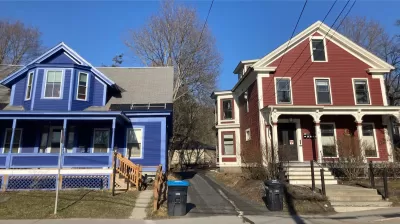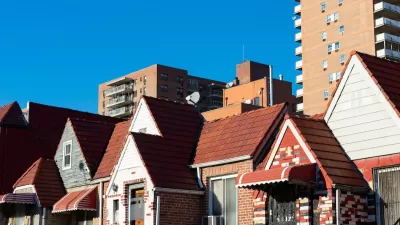The state wants to encourage mid-density development to ease the housing crisis and provide a wider variety of housing options for residents.

A new ‘Homes for All Toolkit’ released in March by the Vermont Department of Housing and Community Development aims to streamline and clarify the development process for missing middle housing. Amy Love Tomasso describes the toolkit for Congress for New Urbanism.
The document provides a guide for small-scale builders and community leaders, highlighting the benefits of small and mid-sized multifamily housing projects.“These home types, which include accessory dwelling units (ADUs), duplexes, small-scale multi-household buildings, and neighborhood-scale mixed-use/live-work buildings, are rooted in Vermont’s traditional development pattern and the New England vernacular style.” Yet over the last century, these traditional housing types have been legislated out of existence.
According to Tomasso, the toolkit “is the start of a movement to bring missing middle housing back to Vermont communities, an opportunity to grow a new generation of developers who value ‘return on community’ as much as return on investment.”
The state plans to pre-approve plans for four different missing middle housing types to make permitting and building easier and more affordable. While cities like Los Angeles have done this at the local scale, Vermont would be the first to issue a statewide pre-approved plan set.
FULL STORY: Vermont is bringing back missing middle housing

Alabama: Trump Terminates Settlements for Black Communities Harmed By Raw Sewage
Trump deemed the landmark civil rights agreement “illegal DEI and environmental justice policy.”

Planetizen Federal Action Tracker
A weekly monitor of how Trump’s orders and actions are impacting planners and planning in America.

The 120 Year Old Tiny Home Villages That Sheltered San Francisco’s Earthquake Refugees
More than a century ago, San Francisco mobilized to house thousands of residents displaced by the 1906 earthquake. Could their strategy offer a model for the present?

Indy Neighborhood Group Builds Temporary Multi-Use Path
Community members, aided in part by funding from the city, repurposed a vehicle lane to create a protected bike and pedestrian path for the summer season.

Congestion Pricing Drops Holland Tunnel Delays by 65 Percent
New York City’s contentious tolling program has yielded improved traffic and roughly $100 million in revenue for the MTA.

In Both Crashes and Crime, Public Transportation is Far Safer than Driving
Contrary to popular assumptions, public transportation has far lower crash and crime rates than automobile travel. For safer communities, improve and encourage transit travel.
Urban Design for Planners 1: Software Tools
This six-course series explores essential urban design concepts using open source software and equips planners with the tools they need to participate fully in the urban design process.
Planning for Universal Design
Learn the tools for implementing Universal Design in planning regulations.
Clanton & Associates, Inc.
Jessamine County Fiscal Court
Institute for Housing and Urban Development Studies (IHS)
City of Grandview
Harvard GSD Executive Education
Toledo-Lucas County Plan Commissions
Salt Lake City
NYU Wagner Graduate School of Public Service





























